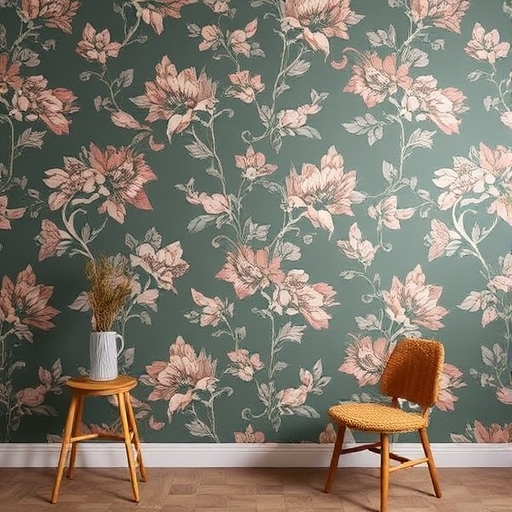Can You Paint Over Wallpaper? A Comprehensive Guide
Painting over wallpaper might seem like a quick and cost-effective way to refresh a room’s look. However, the success of this project hinges heavily on several factors, and a “one-size-fits-all” answer simply doesn’t exist. This comprehensive guide will explore the complexities of painting over wallpaper, outlining when it’s a viable option and when it’s a recipe for disaster.
Assessing Your Wallpaper – The Crucial First Step
Before even considering a brush, you need a thorough assessment of your existing wallpaper. Several key factors determine the feasibility and ultimate success of painting over it:
Wallpaper Type:
Vinyl Wallpaper: This is the most paintable type. Its smooth, plastic-coated surface provides a good base for paint adhesion. However, even with vinyl, the condition of the wallpaper is crucial.
Paper Wallpaper: This is trickier. Thin, delicate paper wallpapers are prone to wrinkling, bubbling, and tearing under the weight of paint. Heavier paper wallpapers have a slightly better chance of success, but still pose a risk.
Anaglypta/Textured Wallpaper: These embossed wallpapers present a unique challenge. While paintable, the deep textures can create an uneven surface, requiring multiple coats and potentially highlighting imperfections.
Fabric-backed Wallpaper: These wallpapers are generally not recommended for painting. The fabric backing can absorb too much moisture from the paint, leading to bubbling, peeling, and mildew.
Wallpaper with Glue Showing: Any glue residue on the surface will interfere with paint adhesion.
Wallpaper Condition-
Regardless of the type, the condition of the wallpaper plays a vital role. Consider these factors:
Loose Seams/Edges: Any loose areas must be repaired or the paint will peel with them.
Bubbling/Wrinkling: These imperfections will be amplified by the paint and may lead to cracking.
Peeling/Flaking: This indicates a significant adhesion problem and requires stripping before painting.
Water Damage/Mildew: This is a serious issue. Mildew needs to be removed, and water damage can weaken the wallpaper, making painting unreliable and possibly unhealthy.
Surface Preparation – The Key to Success
Proper preparation is the most critical aspect of successfully painting over wallpaper. Skipping this step almost guarantees a poor outcome. Here’s a step-by-step guide:
1. Cleaning: Wash the wallpaper with a solution of warm water and mild detergent. Allow it to dry completely. This removes dirt, dust, and loose particles that can prevent adhesion.
2. Priming: This is arguably the most important step. A good primer, specifically designed for wallpaper, creates a bonding layer between the wallpaper and the paint. It seals the surface, preventing the paint from soaking into the wallpaper and causing bubbling or wrinkling. Choose a primer that is appropriate for your wallpaper type.
3. Repairing Imperfections: Use a patching compound to fill in any small holes or tears. Sand smooth after drying.
4. Testing a Small Area: Before committing to the entire room, paint a small, inconspicuous area to assess how the paint adheres and the overall effect. This test allows you to identify any potential problems early on.
When to Strip Instead of Paint
Despite careful preparation, there are situations where stripping the wallpaper is the only viable option:
Severe Water Damage: If the wallpaper is significantly damaged by water, stripping is necessary to prevent mold and mildew growth.
Loose or Peeling Wallpaper: Attempts to paint over loose wallpaper are almost always unsuccessful.
Heavily Textured or Fabric-Backed Wallpaper: These types are difficult to paint effectively, and the result is often unsatisfactory.
Multiple Layers of Wallpaper: Painting over multiple layers can add significant weight and increase the risk of peeling.
Uncertain Wallpaper Type: If you’re unsure of the type of wallpaper, it’s safer to strip it.
Painting Over Wallpaper – A Practical Guide
Once you’ve properly prepared the surface, painting over wallpaper is relatively straightforward. Remember to use a high-quality paint designed for adhesion to wallpaper. A satin or eggshell finish is generally recommended as it is more durable and washable than flat paint.
Apply Thin Coats: Avoid heavy coats, as these are more likely to cause bubbling and cracking. Multiple thin coats are preferable.
Use a Good Quality Brush/Roller: Invest in a high-quality brush or roller to ensure smooth, even coverage.
Allow Sufficient Drying Time: Allow each coat to dry completely before applying the next. This helps prevent problems with adhesion and ensures a durable finish.
Consider a Second Primer Coat: For highly absorbent or textured wallpapers, a second coat of primer can significantly improve results.
Choosing the Right Paint
The choice of paint is crucial. Use a paint designed for adhesion to wallpaper. Look for paints specifically labeled as “wallpaper primer” or “paint for wallpaper”. These paints have additives that help them adhere better to the challenging surface of wallpaper.
FAQ: Painting Over Wallpaper
Q: Can I paint over dark wallpaper with light paint? A: Yes, but it may require multiple coats to achieve sufficient coverage. A primer specifically designed for dark walls is highly recommended.
Q: How long should I wait between coats of paint? A: Allow at least 4-6 hours of drying time between coats, depending on the paint and environmental conditions. Check the paint can for specific recommendations.
Q: What happens if I paint over wallpaper and it peels? A: This indicates that the wallpaper was not properly prepared, or the paint was not suitable. You’ll likely have to strip the wallpaper and start again.
Q: Can I use regular primer on wallpaper? A: While possible, a dedicated wallpaper primer is recommended for better adhesion and results.
* Q: What type of paint is best for painting over wallpaper? A: Satin or eggshell finishes are generally recommended for their durability and washability.
Painting vs. Stripping – A Simple Comparison
| Feature | Painting Over Wallpaper | Stripping Wallpaper |
|---|---|---|
| Cost | Less expensive initially | More expensive and time-consuming |
| Time | Less time-consuming initially | Significantly more time-consuming |
| Effort | Less physically demanding | More physically demanding |
| Suitability | Dependent on wallpaper type and condition | Suitable for most situations, especially poor condition |
| Potential Issues | Bubbling, peeling, uneven finish if improperly prepared | Requires disposal of waste and potentially damage to walls |
Conclusion
Painting over wallpaper can be a successful and cost-effective way to update a room’s appearance, but only if approached carefully and with proper preparation. Thoroughly assessing the wallpaper’s type and condition is paramount. Investing in the right primer and paint, and following the preparation steps meticulously, are crucial for achieving a smooth, durable, and long-lasting finish.
However, when in doubt, stripping the wallpaper offers the safest and most reliable route to a perfect paint job. Remember, the time and effort saved by painting over unsuitable wallpaper is often lost to costly repairs and frustrating re-work. Prioritize proper preparation and assessment to ensure a successful project.

